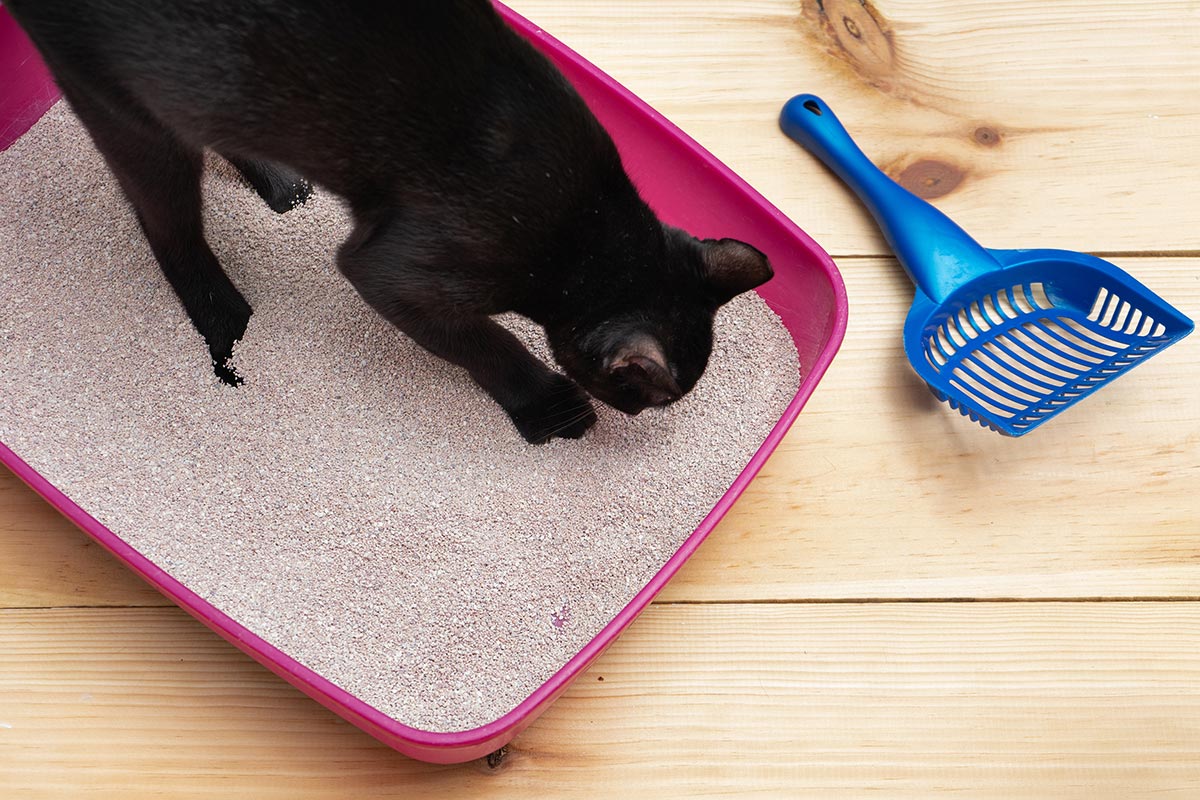15 Feb 2022
Advising clients on toxoplasmosis
Ian Wright explains the causes of this disease, which can infect humans and cats, and the most effective measures to avoid it.

Image © Guajillo studio / Adobe Stock
Toxoplasma gondii is apicomplexan protozoa that inhabits the intestines of a variety of domestic and wild animals. It carries significant zoonotic risk as well as potentially causing disease in the feline definitive host and abortion in sheep.
Control of human toxoplasmosis is based predominantly on sound hygiene and food preparation practice, and much of the zoonotic risk can be mitigated through sound advice to clients. This advice needs to be delivered while keeping risk in perspective, however, so as not erode the human-animal bond.
One of the few parasites with a name that is recognisable to the public and associated with zoonotic infection is Toxoplasma gondii.
It has the potential to cause significant human and feline disease, and is the second-most common cause of infectious ovine abortion.
No effective preventive treatment or vaccine for cats exists, so hygiene and husbandry form the basis of disease control.
Existing evidence suggests that T gondii infects all mammals, but only felids act as a definitive host, producing oocysts in the intestine, which are then passed in the faeces (Boothroyd, 2009).
Although cats can be infected through the ingestion of oocysts, they most commonly acquire the infection by ingesting tissue cysts. This occurs through predation of intermediate hosts, such as rodents and birds, by feeding raw or undercooked meat or, less commonly, via access to aborted ovine material.
Intermediate hosts, including humans, are infected either transplacentally or through consumption of oocysts.
The oocysts are easily disseminated into surface water where they can survive for several months, making water as well as humid soil or feedstuffs contaminated with cat faeces a prime source of infection.
Intermediate hosts may also be infected through consumption of tissue cysts in raw or undercooked meat – this is a significant source of human infection.
Veterinary professionals play a vital role in dispensing accurate control advice, as well as keeping disease concerns in perspective and allaying public fears.
This is of particular concern to pregnant cat owners or immunosuppressed individuals who may be worried about the risk that their pet cat represents.
Nurses and technicians may also face questions surrounding the risk of certain professions – particularly owners working in catteries, farms and abattoirs.

Toxoplasmosis in cats
Clinical toxoplasmosis is rare in cats, and most immunocompetent adults will remain subclinical carriers. Kittens infected in utero can show signs of infection after birth, and prenatal infections of kittens are frequently fatal.
The reasons for clinical manifestations in adult cats are not fully understood, but thought to be linked with immunosuppression. This may be secondary to the use of immunosuppressive drugs or viral pathogens such as FeLV and FIV.
Affected animals show a variety of systemic signs including fever, anorexia, abdominal pain and dyspnoea. Uveitis and central nervous disorders may also develop.
When oocysts are shed by infected cats, it is in large numbers. This occurs, however, for a short period of time, and repeat shedding is rare. This, in combination with the small size of the oocysts (typically 12.5µm×10.5µm, thin shelled) makes detection by faecal examination difficult.
Diagnosis is therefore based on a combination of clinical signs and serum antibody detection. Serology should be interpreted with care, as clinical signs may develop before antibodies are present.
Not all cats with subclinical infections will display antibody titres, but antibodies may also be present in the absence of clinical signs.
Faecal PCRs are now commercially available and are useful for supporting clinical diagnosis, as well as helping to ascertain the presence of active infection. In clinical cases, treatment with clindamycin can be useful at 12.5mg/kg twice daily for up to four weeks.
This can help to resolve clinical signs, but does not eliminate infection. Clinical outcomes are improved if treatment is started early, so speculative treatment is justified if clinical infection is strongly suspected.
Cats with acute toxoplasmosis should be monitored for body cavity effusions, pneumonia, hepatopathies, pancreatitis, encephalomyelitis and myocarditis.
Additional supportive therapy may be required, such as anticonvulsants, diuretics, angiotensin-converting enzyme inhibitors and analgesics, depending on the clinical presentation and organs affected. No evidence that treatment has any effect on oocyst shedding exists, so use of antibiotics is contraindicated in cats not exhibiting clinical signs, irrelevant of their serological status.
Zoonotic disease
As many as two billion people are thought to be infected with Toxoplasma worldwide and, for most, the consequences of infection will be minimal. While healthy adults have a low risk of developing acute toxoplasmosis if infected, immunocompromised individuals, however, or children infected in utero, can suffer from severe ocular and cerebral signs that can lead to blindness or death.
Zoonotic disease can be broadly grouped into three different categories.
Acquired toxoplasmosis
Acquired toxoplasmosis occurs worldwide through exposure to oocysts via environmental contamination or via the consumption of tissue cysts in undercooked or raw meat. The seroprevalence of human T gondii infection has decreased significantly in Europe.
This is thought to be due to changes in eating habits, such as reduced foraging of wild fruit and vegetables, and decreased consumption of raw or undercooked meat.
Waterborne infection and contamination of fruit and vegetables from kitchen gardens and allotments continues to be a significant source of infection (Boothroyd, 2009). Strains of T gondii in Europe and North America seem to be less virulent than those found in South America (Ajzenburg, 2012) and many cases are subclinical. Concerns about adult infection should, therefore, be kept in perspective.
Clinical disease can, however, occur in otherwise healthy, immunocompetent adults. Ocular toxoplasmosis is one of the most frequently identified causes of uveitis (Weiss and Dubey, 2009) and can also be associated with systemic inflammatory disease, cancer and multiple disorders of the brain (Ngo et al, 2017).
Infection has been identified as a risk factor for schizophrenia, bipolar disorders, epilepsy and migraine (Flegr, 2013).
Congenital toxoplasmosis
If women are infected while pregnant, transplacental infection can occur. Children infected in utero can suffer from severe, sometimes fatal toxoplasmosis. This may be ocular, cerebral or a generalised form affecting multiple organs.
Infections acquired during the first trimester usually result in miscarriage or abortion. Women infected during the second trimester may have children that survive birth, but with severe, sometimes life-threatening, defects.
Children infected in the third trimester tend to be less severely affected, with ocular or cerebral defects developing later on in life.
Opportunistic infection
Opportunistic infection affects immunocompromised patients such as those suffering from HIV, undergoing chemotherapy or transplant patients.
Infection in these individuals can be devastating, leading to severe CNS and ocular signs, with potentially fatal complications.

Control of human toxoplasmosis and advice to clients
The potentially serious nature of toxoplasmosis means that exposure to infection should be kept to a minimum. Educational messages to clients regarding toxoplasmosis can be positive, however, highlighting that risk of infection and subsequent disease can be kept to a minimum by simple control measures.
Use of social media, waiting room posters and practice websites is useful to promote positive messages around hygiene and food preparation practices, with information taking the form of diagrams, videos and infographics. Some control measures include:
- Thorough cleaning of litter trays – daily cleaning will ensure that any oocysts shed do not have time to sporulate and become infective. This should not be carried out by pregnant women.
- Good hand hygiene – to reduce the risk of oocyst ingestion. Pregnant women should ideally wear gloves when working with soil and handling sand from sandpits/boxes where cats frequently defecate and bury their faeces. Pregnant women should also not handle lambs or kids due to risk of hand-mouth contamination by contact with recently infected dams during delivery. If they must handle them, strict hygiene must be maintained.
- Thorough washing of fruit and vegetables – to reduce the risk of oocyst contamination. Cats are frequent visitors to allotments and kitchen gardens, so particular attention should be paid to fruit and vegetables from these sites intended for raw consumption.
- Covering of sandpits when not in use – cats frequently defecate in sandpits where exposure to faecal borne parasites such as T gondii can occur.
- Cooking of meat – to destroy tissue cysts before consumption. Meat should be eaten after thorough cooking or, if intended for raw or rare consumption, after freezing at -20°C for at least two days.
- Monitoring of serological status – the serological status of pregnant women is important as seroconversion during pregnancy is a significant risk. This must be monitored through pregnancy if women are initially seronegative as the stage of pregnancy that infection occurs is also important in terms of disease outcomes (Robert-Gangneux and Darde, 2012).
There is no specific need for cats to be removed from households with a pregnant family member if these measures are followed. Keeping cats indoors if possible, to minimise hunting behaviour, and feeding them a cooked diet, however, are sensible precautions.
Most of the routes of Toxoplasma exposure do not arise from cat ownership, but from indirect exposure (undercooked food, environmental contamination of waterways, allotments, farms and so forth) and this should be made clear to concerned cat owners.
Pregnant or immune suppressed owners may ask if testing their cats is worthwhile in terms of assessing their relative disease risk.
Serology is not useful in this respect as not all infected cats are seropositive, and no correlation exists between seropositivity and shedding of oocysts.
Avoiding the feeding of unprocessed raw diets and preventing access of cats to ruminant feed stores will also help to reduce the risk of oocyst-caused abortion storms in sheep.
Conclusions
Toxoplasmosis is a disease very much at the forefront of public awareness as its links to complications during pregnancy are well known, and news reports highlight links to psychiatric disorders and suicidal tendencies (an example).
This will lead concerned clients to consult veterinary professionals who will find the topic broached at kitten checks, reception, and miscellaneous consults such as flea and weight checks.
T gondii poses a significant zoonotic disease risk, and clients should be advised about best practice to minimise these risks, but they should also be kept in perspective so that the human-cat bond is not eroded.
References
- Ajzenberg D (2012). High burden of congenital toxoplasmosis in the United States: the strain hypothesis? Clinical Infectious Diseases 54(11): 1,606-1,607.
- Boothroyd JC (2009). Toxoplasma gondii: 25 years and 25 major advances for the field, International Journal of Parasitology 39(8): 935-946.
- Flegr J (2013). How and why Toxoplasma makes us crazy, Trends in Parasitology 29(4): 156-163.
- Ngo HM et al (2017). Toxoplasma modulates signature pathways of human epilepsy, neurodegeneration and cancer, Science Reports 7(1): 11496.
- Robert-Gangneux F and Darde ML (2012). Epidemiology of and diagnostic strategies for toxoplasmosis, Clinical Microbiology Reviews 25(2): 264-296.
- Weiss LM and Dubey JP (2009). Toxoplasmosis: a history of clinical observations, International Journal of Parasitology 39(8): 895-901.
